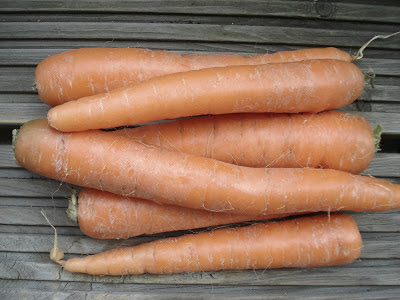Abundance
As Irene moves up the East Coast, there is nothing to do but to batten down the hatches, sit tight, and ride the storm out. I'm not particularly worried for myself: Montreal isn't exactly on her path, merely on the outer edges of her tropical wrath. I am more afraid for the folks in the Lower Saint-Lawrence. They are just emerging from the havoc that was spring, and must now hunker down for possibly more flooding. I hope that everyone is safe, and that the threat of Irene is nothing more than a media frenzy.
Since my refrigerator is full of produce, I might as well cook as long as the electricity holds out. If you swing by your local farmers' market (on a quieter, more pleasant day), you will see an abundance of produce sold by the bushel. For those of you with vegetable gardens, you are likely harvesting more than you know what to do with right about now. The end of the season is around the corner, and the fields seem to be sending out the message that it is time to be putting up for the barren months. The vegetables are gorgeous and prices are staggeringly low, and if you have the space and time to process the lot (and a car to cart it all home!), you can be nearly self-sufficient over the winter months.
Ratatouille is the ideal dish for preserving the flavours of summer. This vegetable stew is actually perfect for whiling away the time on a dreary summer day: the warm aromas will permeate every nook and cranny of your home, and stave off August chills, while the weather is raging outdoors. (As long as you have power…)
Ratatouille recipes often call for tough, pungent herbs such as those found in the mix Herbes de Provence; but, do beware: some commercial mixes contain lavender, which can be pleasant to some, or absolutely vile to others. One way to avoid an unpleasant surprise is to use up the herbs (fresh or dried) you most likely already have on hand: thyme, rosemary, oregano, savory, (and lavender, if you wish) are most commonly found in Herbes de Provence.
There are several ways to make ratatouille, probably as many as there are cooks who make it. The vegetables can be roughly chopped into large chunks for a more rustic feel, or carefully diced into perfect, little cubes. They can be roasted, grilled, fried, or stewed, depending on how much time you want to spend toiling over them. I usually prefer to chop the vegetables into smallish cubes, and to pan-roast them over low heat. The result is a versatile, full-flavoured stew that can also double as pasta sauce.
Yields about 3 litres/quarts
1 medium onion
3 or more cloves of garlic
6 (500g/ 1lb) medium tomatoes, or 1 can
2 bell peppers, preferably not green
1 or 2 zucchini or other summer squash
1 chile pepper, dried or fresh, seeds removed, optional
3 tsp herbs, or to taste
125ml/ ½ cup oil, preferably olive oil
salt
Peel and chop onion. Peel garlic, and leave whole.
In a wide skillet or sauce pan, heat the oil. When it starts to shimmer, add the onion and garlic.
Turn heat down to medium-low. Leave the onion and garlic cloves to cook down slowly, about 10 minutes.
Meanwhile, chop the tomatoes. Chop them according to your tolerance of cooked tomato peel, i.e. if you dislike the tough bits of peel, chop finely or use canned, crushed tomatoes.
When the onion is translucent, crush the garlic with the back of a spoon. Stir around until the smashed garlic starts to stick to the bottom of the pot. Add the herbs, the chile if using, and a generous pinch of salt.
When the onion and garlic begin to colour, add the tomatoes. Let simmer for another 10 to 15 minutes.
Chop the eggplant. The peel is usually tender, so it need not be removed. However, you might prefer dicing the bits with skin more finely than the fleshy parts.
Check on the tomatoes: they should be cooked down to the point where a stirring spoon would leave a clear channel in the sauce, and the oil has separated from the vegetables. Add the eggplant; stir to make sure every bit is covered in oil. Leave to roast for about 10 minutes.
Remove the tail and core of the peppers, and chop.
Returning to the skillet, check the seasoning; add more salt or herbs as needed. Throw in the chopped peppers, cover the pot, and cook for 5 minutes.
Top and tail the zucchini, and chop. Add to the pot, and simmer only until heated through, about 5 minutes. They are at their best when under-cooked.
Chopped, fresh herbs such as parsley and basil can be added just before serving.
Nowadays, ratatouille is often served as a side dish in restaurants, but it is actually a vegetarian main course. My mother always served it with steamed and buttered couscous, but it also pairs well with rice or any other grain. As I mentioned earlier, ratatouille can double as a pasta sauce (a great way to squeeze in a few extra portions of veggies), but it is also rather lovely served at room temperature or even cold. Try it mixed with some cooked and/or sprouted wheat by way of salad.
Bon app’!









Comments
Post a Comment